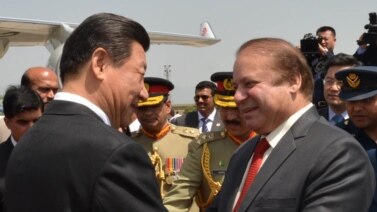
Indian Prime Minister Narendra Modi recently pointed out that India imports nearly 60 percent of its defense needs. In fact, a new report by the Stockholm International Peace Research Institute – SIPRI – finds that India was the world’s biggest arms importer in the last five years.
Mr. Modi wants to change that. He is urging a “Made in India” policy that extends to the country’s defense needs. He has even said the country should try to export weapons.
Foreign manufacturers
The United States is already partnering with India to produce weapons with Indian companies. For example, the U.S.-based Lockheed Martin company joined with India’s Tata Advanced Systems to produce parts for the C-130J Super Hercules plane.
Rahul Madhavan is the director for aerospace and defense with the U.S.-India Business Council. He says the Defense Trade and Technology Initiative is a sign of change. That program calls for U.S. and Indian defense firms to produce weapons together rather than continue the buyer-seller relationship.
Mr. Madhavan said the program is a sign of the power the U.S. sees in the Indian market.
“You can look at India as an export market for the world… 'Make with India,'” not just “Make in India,” he says.
Similarly, Sweden's Saab is trying to sell their light, single-engine Gripen planes to India’s air force. Saab is proposing to produce the Gripen in India with a local partner.
China’s growing arms exports
The push to develop India’s defense industry comes as China’s defense exports are growing.
Currently, the U.S. remains the largest weapons exporter; however, the SIPRI report says China was the third largest weapons exporter between 2010 and 2014. And, the report says, China’s weapons exports are growing quickly. The weapons are heading to Pakistan, Bangladesh, Myanmar and many African countries.
Weapons exports are more than just trade deals. Jon Grevatt of the defense intelligence group IHS Jane’s says China’s growth in exports has also increased its strategic influence, or power.
Mr. Grevatt says many of China’s customers are “economically challenged” countries and must rely on China until they pay for the cost of the weapons.
A more powerful China is a concern for India and the U.S., says Lisa Curtis, a senior researcher at the Heritage Foundation in Washington, D.C. Ms. Curtis says the U.S. sees India’s growing defense budget as a way to balance China.
Challenges for India’s defense industry
But many experts are asking whether India’s defense industry can really challenge China’s export business and political weight.
Some foreign policy experts believe that, despite U.S. interest in helping the Indian defense industry grow, a weak Indian defense industry makes this unlikely. After all, India has been trying to develop its defense industry since the 1950s – well before China.
One reason India’s defense industry is slow to grow is restrictive policies. A law limits the level of foreign ownership in a defense partnership to 49 percent. In other words, a U.S. defense firm would not have a majority share in the company.
Mr. Madhavan of the U.S.-India Business Council says U.S. companies will want to have control of the intellectual property. “Billions of dollars of taxpayer money is invested into research and engineering,” he says.
Most industry experts do not think India will be a major player in global weapons exports soon. In fact, Jon Grevatt of IHS Jane’s says India’s weapons export business will struggle in the global market for many years to come.
I’m Jim Tedder.
Idrees Ali reported this story, with some material from Reuters. Kelly Jean Kelly wrote it for Learning English. Hai Do was the editor.
Words in This Story
initiative - n. a plan or program that is intended to solve a problem
intelligence - n. secret information that a government collects about an enemy or possible enemy
restrictive - adj. limiting or controlling someone or something

